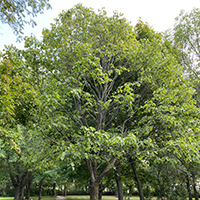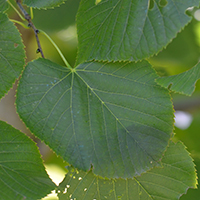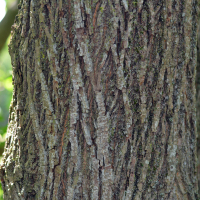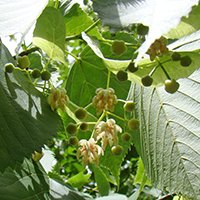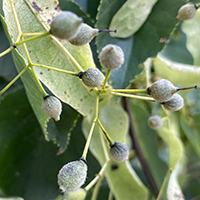What basswood looks like
Size and shape
- Reaches 35 metres tall.
- Grow as large single- or multi-stemmed trunks.
- Twigs have a noticeable zigzag appearance.
Leaves
- Large, heart-shaped leaves.
- Have jagged edges and a short point at the end.
Bark
- Greyish brown with long, narrow ridges.
Flowers
- Fragrant yellow flowers hang from the centre of a leaf-like structure (also known as bract).
Fruit
- Round greyish brown fruit.
- When the fruit fall, the bract acts like a helicopter wing and carries the seeds away.
Where basswood is found
Basswood is common across Southern Ontario, in Central Ontario and north from Lake Nipissing to Sault Ste. Marie. Basswood trees can also be found in the northwest near the Ontario-Minnesota border.
What you need to know to grow basswood
- Moisture: grows best in moist sites.
- Shade: can grow in full shade or full sun.
- Soil: grows best in rich, well-drained soils.
Benefits and uses of basswood
Wildlife benefits
Basswood trees provide food and habitat to many wildlife species.
- White-tailed deer browse basswood stems.
- Several small mammal and bird species eat basswood berries.
- Bees are very attracted to basswood flowers because they bloom in midsummer when few other trees are in bloom.
- Basswood trees are prone to developing hollows that provide nesting habitat and shelter for birds and small mammals.
Commercial uses
Basswood is valued for its light, workable wood. It is used for:
- small specialty items
- crafts
- carvings
- musical instruments
- pulp
Basswood is also an excellent ornamental tree.
Fun facts about basswood
- Basswood leaves are very rich in nutrients. Mulching fallen basswood leaves in the fall with a lawnmower can help fertilize your lawn and other trees.
- The inner bark of basswood trees is very fibrous and can be used to make baskets and nets.
Updated: October 17, 2023
Published: July 18, 2014
